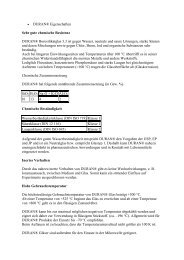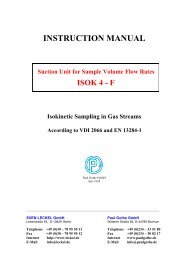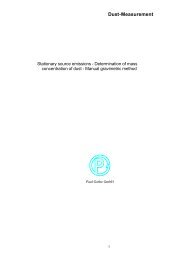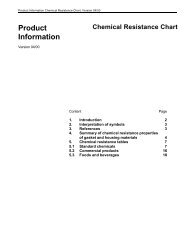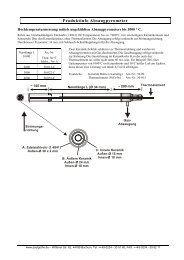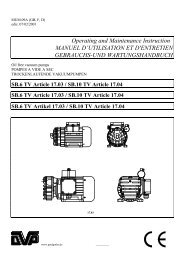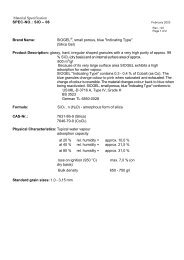Chemical resistance of NIROSTA steels - Rovasta
Chemical resistance of NIROSTA steels - Rovasta
Chemical resistance of NIROSTA steels - Rovasta
Create successful ePaper yourself
Turn your PDF publications into a flip-book with our unique Google optimized e-Paper software.
The corrosion mechanism is largely<br />
the same as for pitting, although<br />
crevice geometry and the type <strong>of</strong><br />
materials forming the crevice exert an<br />
additional influence. Since crevice<br />
attack occurs under less serious<br />
corrosion conditions than pitting,<br />
attempts should be made to design<br />
out crevices in components to be<br />
used in chloride-bearing media.<br />
Assuming a homogeneous distribution<br />
<strong>of</strong> alloying elements, a rough<br />
guide to the pitting and crevice corrosion<br />
<strong>resistance</strong> <strong>of</strong> stainless steel is the<br />
efficiency sum (W) <strong>of</strong> % Cr + 3.3 x<br />
% Mo + 30 x % N (see Fig.). The<br />
influence <strong>of</strong> nitrogen as an alloying<br />
element is, however, more complex<br />
than expressed by this equation. The<br />
high efficiency expressed in the<br />
factor <strong>of</strong> 30 will only apply in full<br />
in the case <strong>of</strong> high-alloy <strong>steels</strong> with<br />
increased molybdenum contents.<br />
A material’s inherent <strong>resistance</strong><br />
to pitting and crevice corrosion can<br />
only be fully achieved if the surface<br />
quality <strong>of</strong> the material is pristine,<br />
i. e. bright metallic. It is therefore<br />
important to remove any heat tinting<br />
or scale left after welding, iron particles<br />
or rust from other sources,<br />
grinding residue etc.<br />
Stress-corrosion cracking<br />
Stainless <strong>steels</strong> in media containing<br />
specific components – in particular<br />
chloride ions – and subjected<br />
at the same time to tensile stresses<br />
may suffer corrosion attack and<br />
cracking, even if the steel displays<br />
adequate <strong>resistance</strong> to the medium<br />
when not under mechanical load.<br />
This phenomenon is known as stresscorrosion<br />
cracking and is not caused<br />
exclusively by service stresses; the<br />
blame frequently lies with internal<br />
stresses applied during processing,<br />
e.g. welding, grinding or cold forming.<br />
As with pitting and crevice corrosion,<br />
the risk <strong>of</strong> chloride-induced<br />
stress-corrosion cracking becomes<br />
greater as the temperature and chloride<br />
concentration increase. There<br />
are, however, other material-related<br />
variables. For example, austenitic<br />
steel grades 18/10-CrNi and<br />
17/12/2-CrNiMo are at particular<br />
risk <strong>of</strong> chloride-induced stress-corrosion<br />
cracking when temperatures<br />
exceed 50 °C. Resistance can be<br />
distinctly enhanced by increasing the<br />
molybdenum and in particular the<br />
nickel content <strong>of</strong> the material. In<br />
comparison, ferritic and austeniticferritic<br />
stainless <strong>steels</strong> are relatively<br />
insensitive to corrosion <strong>of</strong> this type.<br />
How to use the table<br />
Even though the figures provided<br />
in the following have been<br />
calculated in laboratory tests using<br />
pickled specimens with the best<br />
possible microstructure – annealed,<br />
tempered or quenched – they provide<br />
a basic guide to applicability.<br />
It must however be emphasised<br />
that under practical conditions agents<br />
rarely occur in such pure form, and<br />
that even slight additions, e. g. <strong>of</strong><br />
oxidising or reducing materials, can<br />
weaken or intensify corrosive attack.<br />
Deposits, such as those occasionally<br />
found on the walls above the bath<br />
surface or at other points, and condensation<br />
in the steam chamber <strong>of</strong><br />
an enclosed apparatus can under<br />
certain circumstances greatly modify<br />
the conditions for corrosive attack.<br />
Exact knowledge <strong>of</strong> corrosive<br />
conditions is thus vital in selecting the<br />
right grade <strong>of</strong> steel. The best (and<br />
sometimes only) way <strong>of</strong> gaining information<br />
on the <strong>resistance</strong> <strong>of</strong> a material<br />
in the corrosive medium in question is<br />
to carry out tests on a specimen<br />
under actual service conditions,<br />
taking into consideration not only the<br />
composition and concentration <strong>of</strong> the<br />
corrosive medium but also the temperature,<br />
the pH value and other<br />
variables.<br />
We would be pleased to provide<br />
specimens <strong>of</strong> the relevant materials<br />
for test purposes.<br />
Classification <strong>of</strong> <strong>NIROSTA</strong> ® -/ASTM grades by group<br />
Gr. 1 Gr. 2<br />
4000/<br />
410 S<br />
4002/<br />
405<br />
4003/<br />
A240/<br />
A240M<br />
4006/ 4016/<br />
410 430<br />
4021/ 4057/<br />
(420) 431<br />
4024/<br />
(410)<br />
4120<br />
4028/ 4305/<br />
(420) 303<br />
4031 4427/<br />
(420) 316 F<br />
4034/ 4509/<br />
(420) 441<br />
4313<br />
4510/<br />
439<br />
4512/<br />
(409)<br />
4511<br />
4589 4520<br />
Gr. 3<br />
4113/<br />
434<br />
4521/<br />
444<br />
4568<br />
631<br />
Gr. 4<br />
4301/<br />
304<br />
4303/<br />
(305)<br />
4306/<br />
304 L<br />
4307/<br />
304 L<br />
4310/<br />
(301)<br />
4311/<br />
304 LN<br />
4315/<br />
304 N<br />
4318/<br />
301 LN<br />
4541/<br />
321<br />
4544<br />
4546<br />
4550/<br />
347<br />
Gr. 5<br />
4401/<br />
316<br />
4404/<br />
316 L<br />
4429/<br />
316 LN<br />
4435/<br />
316 L<br />
4436/<br />
316<br />
4438/<br />
317 L<br />
4439<br />
4462<br />
4501<br />
4561/<br />
316 Ti<br />
4571/<br />
316 Ti<br />
4465<br />
4465<br />
4539<br />
4539<br />
4565 S<br />
4565 S<br />
3



